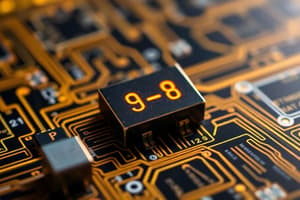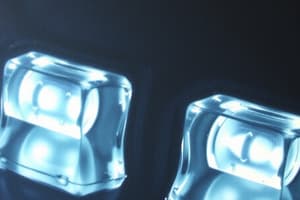Podcast
Questions and Answers
What happens to the depletion region when a forward voltage is applied across a p-n junction?
What happens to the depletion region when a forward voltage is applied across a p-n junction?
- It narrows. (correct)
- It disappears.
- It widens.
- It remains the same.
What is the effect of a forward voltage on the electric field in the depletion region of a p-n junction?
What is the effect of a forward voltage on the electric field in the depletion region of a p-n junction?
- The electric field reverses its direction.
- The electric field is strengthened.
- The electric field remains unchanged.
- The electric field is weakened. (correct)
Which of the following statements is TRUE about the minority carrier concentrations in a forward-biased p-n junction?
Which of the following statements is TRUE about the minority carrier concentrations in a forward-biased p-n junction?
- They increase significantly. (correct)
- They decrease significantly.
- They become equal to the majority carrier concentrations.
- They remain unchanged.
What happens to the depletion region when a reverse voltage is applied across a p-n junction?
What happens to the depletion region when a reverse voltage is applied across a p-n junction?
What is the primary reason for the increase in reverse saturation current?
What is the primary reason for the increase in reverse saturation current?
What is the main characteristic that distinguishes forward bias from reverse bias in a p-n junction?
What is the main characteristic that distinguishes forward bias from reverse bias in a p-n junction?
In a forward-biased p-n junction, what happens to the flow of majority carriers?
In a forward-biased p-n junction, what happens to the flow of majority carriers?
What is the main factor determining the degree of narrowing or widening of the depletion region in a p-n junction under bias?
What is the main factor determining the degree of narrowing or widening of the depletion region in a p-n junction under bias?
What is the relationship between the reverse current of a Si diode and temperature in the forward bias region?
What is the relationship between the reverse current of a Si diode and temperature in the forward bias region?
What happens to the reverse breakdown voltage of a Si diode as temperature increases?
What happens to the reverse breakdown voltage of a Si diode as temperature increases?
Which type of resistance is associated with the diode's response to an AC signal?
Which type of resistance is associated with the diode's response to an AC signal?
What does the dynamic resistance of a diode represent?
What does the dynamic resistance of a diode represent?
What is the purpose of an equivalent circuit for a diode?
What is the purpose of an equivalent circuit for a diode?
What is a piecewise-linear equivalent circuit?
What is a piecewise-linear equivalent circuit?
Which of the following is not a typical parameter specified for a diode?
Which of the following is not a typical parameter specified for a diode?
Which of these diode parameters is directly related to the diode's ability to withstand reverse voltage?
Which of these diode parameters is directly related to the diode's ability to withstand reverse voltage?
What is the typical forward bias voltage for a silicon diode?
What is the typical forward bias voltage for a silicon diode?
What is the name of the current that flows through a diode under reverse bias conditions?
What is the name of the current that flows through a diode under reverse bias conditions?
Which of the following statements is TRUE regarding the Zener region of a diode?
Which of the following statements is TRUE regarding the Zener region of a diode?
What is the purpose of the Zener voltage (Vz) in a diode?
What is the purpose of the Zener voltage (Vz) in a diode?
How does temperature affect the forward bias voltage required for a diode to conduct?
How does temperature affect the forward bias voltage required for a diode to conduct?
What is the effect of increasing temperature on the reverse current in a diode?
What is the effect of increasing temperature on the reverse current in a diode?
Which type of diode is most sensitive to temperature variations?
Which type of diode is most sensitive to temperature variations?
Which of the following represents the peak inverse voltage (PIV) of a diode?
Which of the following represents the peak inverse voltage (PIV) of a diode?
What is the key characteristic of a diode's operation based on the provided text?
What is the key characteristic of a diode's operation based on the provided text?
How does the application of an external voltage across a diode affect its behavior?
How does the application of an external voltage across a diode affect its behavior?
What does the 'depletion region' refer to in the context of a semiconductor diode?
What does the 'depletion region' refer to in the context of a semiconductor diode?
What is the main factor governing the diffusion of majority carriers across the depletion region?
What is the main factor governing the diffusion of majority carriers across the depletion region?
Why does the majority carrier diffusion occur in a diode even with a potential barrier?
Why does the majority carrier diffusion occur in a diode even with a potential barrier?
What happens to the total potential barrier when a diode is forward biased?
What happens to the total potential barrier when a diode is forward biased?
In the context of a diode, what is the difference between the 'no bias' and 'forward bias' condition?
In the context of a diode, what is the difference between the 'no bias' and 'forward bias' condition?
What is the primary reason for the diffusion of holes and electrons in forward bias?
What is the primary reason for the diffusion of holes and electrons in forward bias?
Flashcards
Diode
Diode
A 2-terminal device that conducts in one direction.
Forward bias
Forward bias
A condition where positive voltage is applied to the p-side and negative to the n-side of a diode.
Reverse bias
Reverse bias
A condition where positive voltage is applied to the n-side and negative to the p-side of a diode.
Depletion region
Depletion region
Signup and view all the flashcards
Diode equation
Diode equation
Signup and view all the flashcards
LED
LED
Signup and view all the flashcards
Zener diode
Zener diode
Signup and view all the flashcards
Bias
Bias
Signup and view all the flashcards
Net Electric Field
Net Electric Field
Signup and view all the flashcards
Carrier Injection
Carrier Injection
Signup and view all the flashcards
Majority Carriers
Majority Carriers
Signup and view all the flashcards
Minority Carriers
Minority Carriers
Signup and view all the flashcards
Reverse Saturation Current
Reverse Saturation Current
Signup and view all the flashcards
Forward-Bias Region
Forward-Bias Region
Signup and view all the flashcards
Reverse-Bias Region
Reverse-Bias Region
Signup and view all the flashcards
Temperature Effect on Reverse Current
Temperature Effect on Reverse Current
Signup and view all the flashcards
Breakdown Voltage
Breakdown Voltage
Signup and view all the flashcards
Types of Resistance
Types of Resistance
Signup and view all the flashcards
Dynamic Resistance
Dynamic Resistance
Signup and view all the flashcards
Equivalent Circuit
Equivalent Circuit
Signup and view all the flashcards
Diode Specifications
Diode Specifications
Signup and view all the flashcards
Thermal Voltage (VT)
Thermal Voltage (VT)
Signup and view all the flashcards
Reverse Saturation Current (Is)
Reverse Saturation Current (Is)
Signup and view all the flashcards
Forward Bias Voltage
Forward Bias Voltage
Signup and view all the flashcards
Zener Voltage (Vz)
Zener Voltage (Vz)
Signup and view all the flashcards
Peak Inverse Voltage (PIV)
Peak Inverse Voltage (PIV)
Signup and view all the flashcards
Effect of Temperature on Diodes
Effect of Temperature on Diodes
Signup and view all the flashcards
Sensitivity to Temperature
Sensitivity to Temperature
Signup and view all the flashcards
Conventional Current Direction
Conventional Current Direction
Signup and view all the flashcards
Study Notes
The Diode - Part 1
- The diode is a 2-terminal device
- A diode ideally conducts in one direction only
- A semiconductor diode is made by joining an n-type (electrons) and a p-type (holes) material
- The term "bias" refers to applying voltage across the terminals to elicit a response
- The depletion region is an area of uncovered positive and negative ions, due to the depletion of free carriers
- Forward bias causes the depletion region to narrow
- Electrons and holes are pushed towards the junction
- Electrons and holes have enough energy to cross the p-n junction
- The electric field opposite to the space charge electric field
- The net electric field in the space charge region is reduced
Diode Equations
- The total current density (J) in the p-n junction is given by the sum of the hole current density (Jp(x)) and the electron current density (Jn(-Xp))
- Jp(x) and Jn(x) equations provided
- The ideal current-voltage relationship presented
- A parameter, J_s, is defined for ease of use
Diode Operating Conditions
- No bias: no current flow, modest depletion region
- Forward bias: depletion region narrows, current flows
- Reverse bias: depletion region widens, little to no current flows
Breakdown Region (Zener Region)
- The diode breaks down at a certain reverse voltage
- The maximum reverse voltage is the peak inverse voltage (PIV) or peak reverse voltage (PRV)
- The voltage needed to enter the zener region is called the Zener voltage (Vz)
Temperature Effects
- Increasing temperature reduces required forward bias voltage
- Increasing temperature increases reverse current
- Germanium diodes are more sensitive to temperature changes than silicon or gallium arsenide diodes
Resistance Levels
- Semiconductors react differently to DC and AC
- Three types of resistance:
- DC (static) resistance
- AC (dynamic) resistance
- Average AC resistance
AC (Dynamic) Resistance
- Dynamic resistance (r_p) is calculated as the ratio of change in voltage (dV) over the change in current(dI)
Diode Equivalent Circuits
- Equivalent circuits represent actual terminal characteristics in a particular operating region
- Piecewise-linear circuits, showing different models
Diode Specification Sheets
- Standardized data about each diode is presented uniformly
- Includes detailed characteristics like forward voltage, maximum forward current, reverse saturation current, reverse voltage rating, maximum power dissipation and capacitance, reverse recovery time, and operating temperature range
Diode Symbol and Packaging
- Various diode symbols
- Different diode packaging types shown
Studying That Suits You
Use AI to generate personalized quizzes and flashcards to suit your learning preferences.




